Smart Pacifier Market Size and Trends
The smart pacifier market is estimated to be valued at USD 467.1 Mn in 2025 and is expected to reach USD 684.5 Mn by 2032, exhibiting a compound annual growth rate (CAGR) of 5.6% from 2025 to 2032.
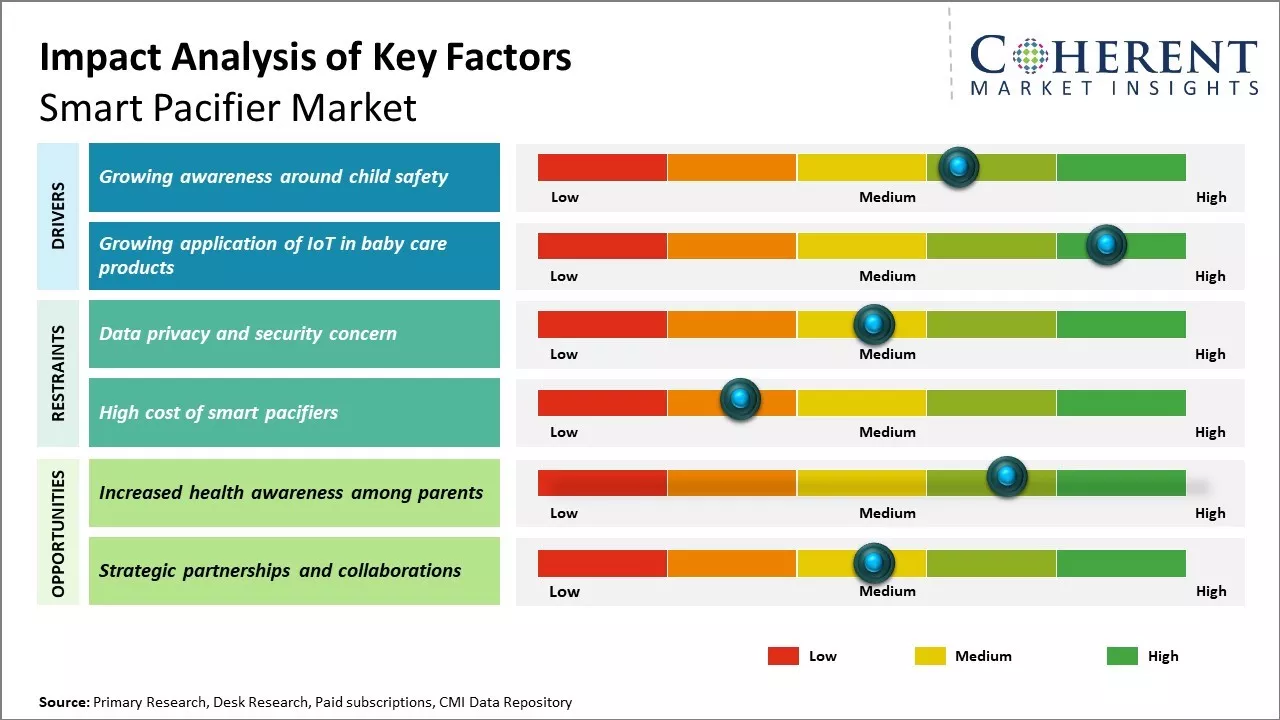
Discover market dynamics shaping the industry: Download Free Sample
The smart pacifier market is expected to witness significant growth over the forecast period. This can be attributed to rising awareness among parents about products that facilitate infant monitoring. In addition, increasing disposable income and growing penetration of internet-connected devices are also driving the use of smart pacifiers globally. Key players are investing heavily in research & development to introduce advanced features such as automatic temperature control and integrated sensors for improved monitoring capabilities, which is further fueling adoption. However, data privacy and security concerns could hamper market growth to some extent. Overall, the future outlook for the smart pacifier market remains quite positive.
Growing awareness around child safety
Parents today are increasingly concerned about the health and well-being of their children. There is widespread awareness that poor sleeping patterns in infants can negatively impact their development. At the same time, parents wish to embrace technology to make parenting easier. This has resulted in greater acceptance of smart technologies that can help track infant sleep cycles and ensure safety. Smart pacifiers address key issues like preventing Sudden Infant Death Syndrome (SIDS) by constantly monitoring the baby's breathing patterns and vital signs. Any abnormality is immediately notified to parents via smartphone alerts. This gives anxious parents peace of mind while their babies sleep. As more parents experience the benefits of such connected care solutions, their willingness to pay a premium for added safety and convenience is likely to increase. Over time, smart pacifiers could become a parenting essential to meet contemporary needs of working parents who need round-the-clock monitoring solutions.
Market Concentration and Competitive Landscape
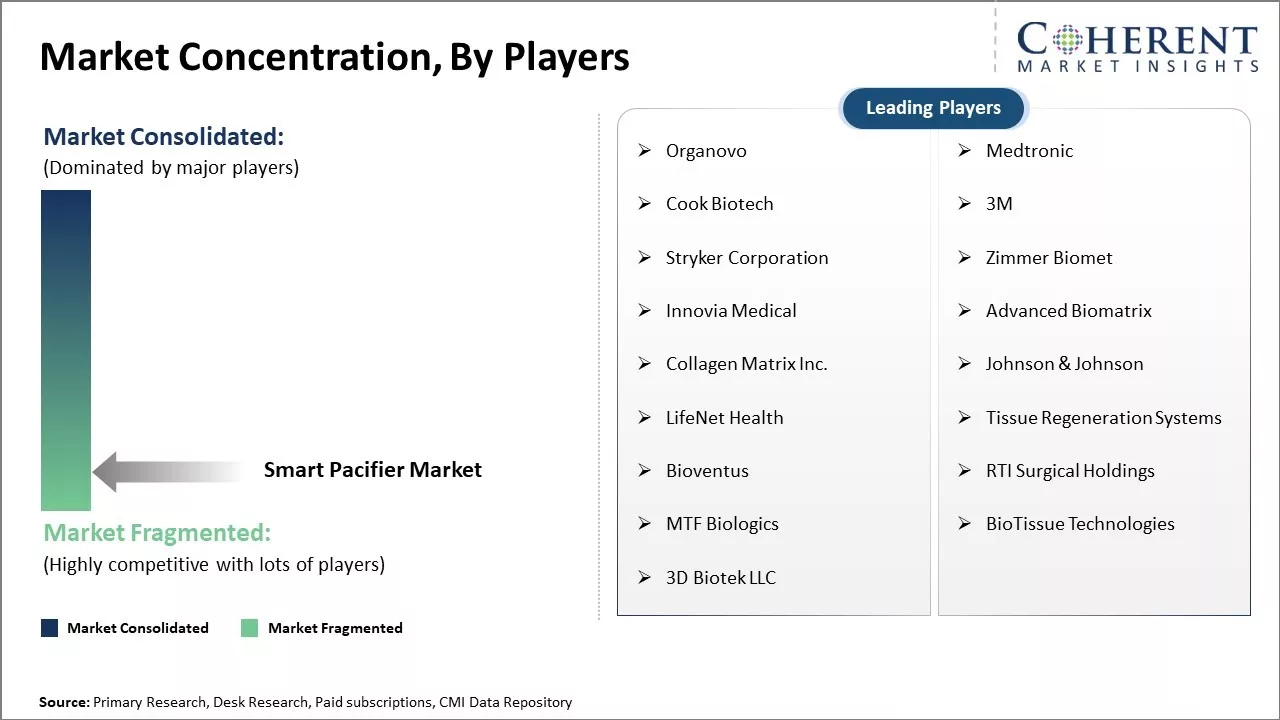
Get actionable strategies to beat competition: Download Free Sample
Growing application of IoT in baby care productsThe introduction of 'Internet of Things' is revolutionizing various industries including baby products. Connected devices are being widely adopted not just in adults' world but also infant care routines. Major baby product manufacturers have realized commercial potential in leveraging IoT and wireless connectivity to develop smart variants of their traditional offerings. This allows remote tracking of babies' eating, sleeping and diaper changing patterns via mobile or web interfaces. It also enables artificial intelligence-based analysis of longitudinal data to provide personalized care tips to parents. With successful integration of advanced technologies, baby product categories like pacifiers are fast emerging as connected devices. This growing application of IoT and associated conveniences is anticipated to spur further demand for smart pacifiers over regular variants. Moreover, lowering costs of sensors and connectivity will make such solutions more affordable to mainstream parents in future.
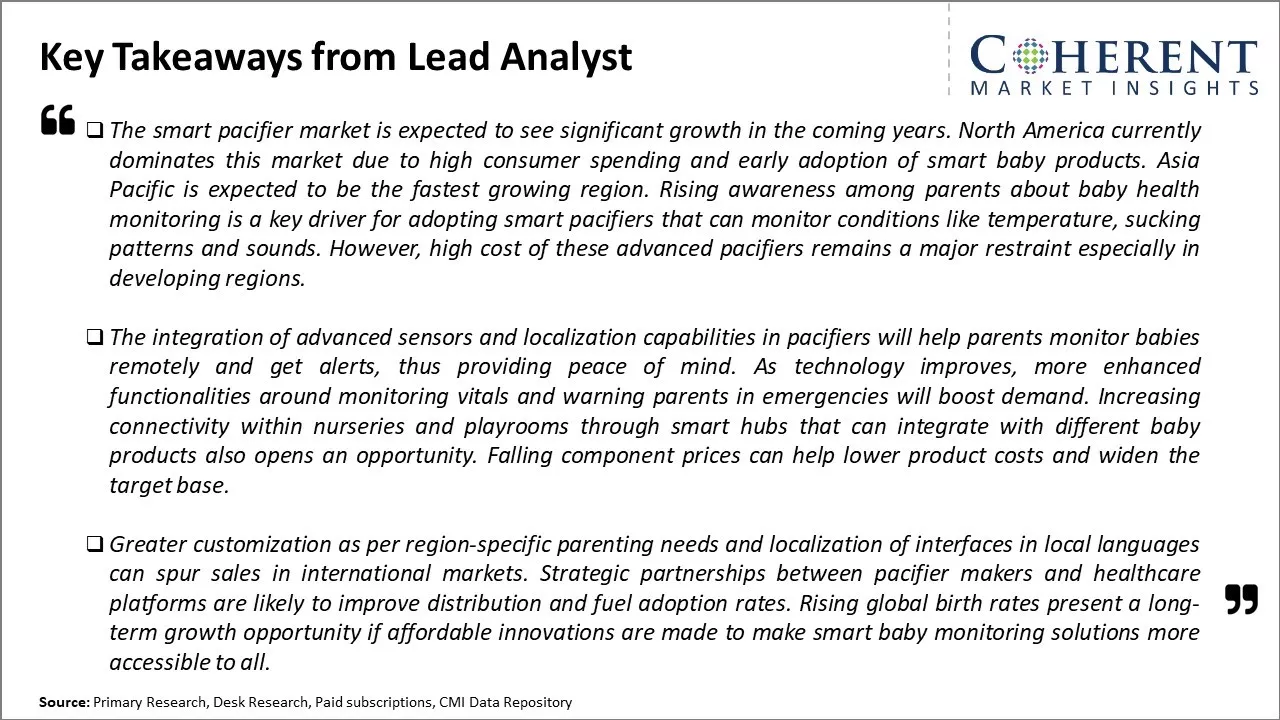
To learn more about this report, Download Free Sample
Market Challenges – Data privacy and security concernOne of the key challenges in the smart pacifier market is ensuring data privacy and security for infants. As pacifiers collect sensitive data on babies' breathing, heart rate, temperature and movements, strict data encryption and access control is necessary to prevent any misuse of children's information. Additionally, making pacifiers durable and water resistant while housing various sensors and connectivity poses engineering hurdles. High research and development costs involved in adding intelligence to pacifiers can be a deterrent for many traditional pacifier manufacturers as well. Affordability is another concern area as smart variants tend to be more expensive.
Market Opportunities – Increased health awareness among parents
Increased health awareness among parents is driving the need for remote baby monitoring solutions. Moreover, advanced analytics of infants' vitals can help detect medical conditions early. Furthermore, regional expansion to untapped markets could provide a major growth opportunity for players in the smart pacifier market. While markets in North America and Europe have seen significant adoption of connectivity-enabled baby care products, there remains huge potential for sales growth in other parts of the world with large newborn populations.
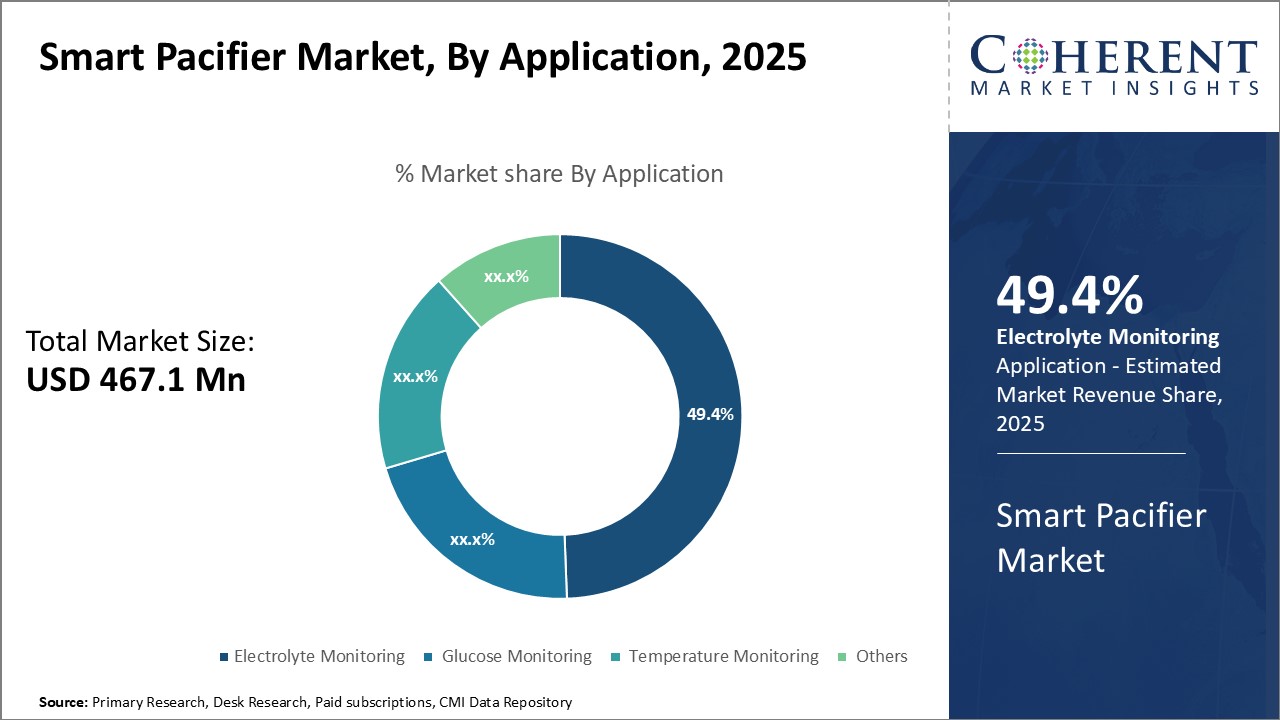
Discover high revenue pocket segments and roadmap to it: Download Free Sample
Insights, By Application: Growing preterm birth rates drives the growth of the electrolyte monitoring segmentThe application segment includes electrolyte monitoring, glucose monitoring, temperature monitoring, and others. The electrolyte monitoring segment is estimated to hold 49.4% share of the market in 2025. Electrolyte imbalance is quite common in preterm infants, often necessitating close monitoring of electrolyte levels. Smart pacifiers equipped with sensors to track electrolyte levels in real-time are gaining popularity as they allow for non-invasive continuous monitoring of babies. This helps detect even minor fluctuations in electrolyte balance at the earliest, enabling timely medical intervention. The growing preterm birth rates especially in developing nations have significantly increased the risk of electrolyte abnormalities in newborns. Several factors such as rising maternal age, lifestyle changes, and environmental pollutants are fueling the preterm birth crisis. Since preterm infants have underdeveloped organs and physiological systems, they are highly vulnerable to electrolyte imbalance. The immature kidneys of preterm babies also have limited ability to regulate electrolyte concentrations in the blood and tissues. All these aspects have amplified the clinical importance of electrolyte monitoring in the neonatal intensive care unit.
Insights, By End User: Rise in the adoption of remote monitoring solutions
The end user segment includes hospitals, specialty clinics, homecare settings, and others. The homecare settings subsegment is estimated to hold 38.6% of the market share in 2025. With advanced connectivity and miniaturized sensors, smart pacifiers enable various parameters like temperature, oxygen saturation, heart rate and more to be seamlessly tracked around the clock at home. This provides several key benefits over traditional in-hospital care. To start with, it allows for early discharge of clinically stable preterm babies, reducing lengthy NICU stays and healthcare costs. Remote monitoring also addresses the escalating shortage of beds in NICUs. For patients and families, it offers a more comfortable environment for recovery and bonding compared to the hospital setting. Additionally, continuous digital monitoring at home aids faster identification of any deterioration, minimizing the delay in seeking medical assistance. Rising prematurity rates have led to a major surge in pediatric home healthcare over the past decade. Homecare also eases the pressure on an overburdened healthcare system by shifting appropriate post-stabilization care outside the hospital.
Regional Insights
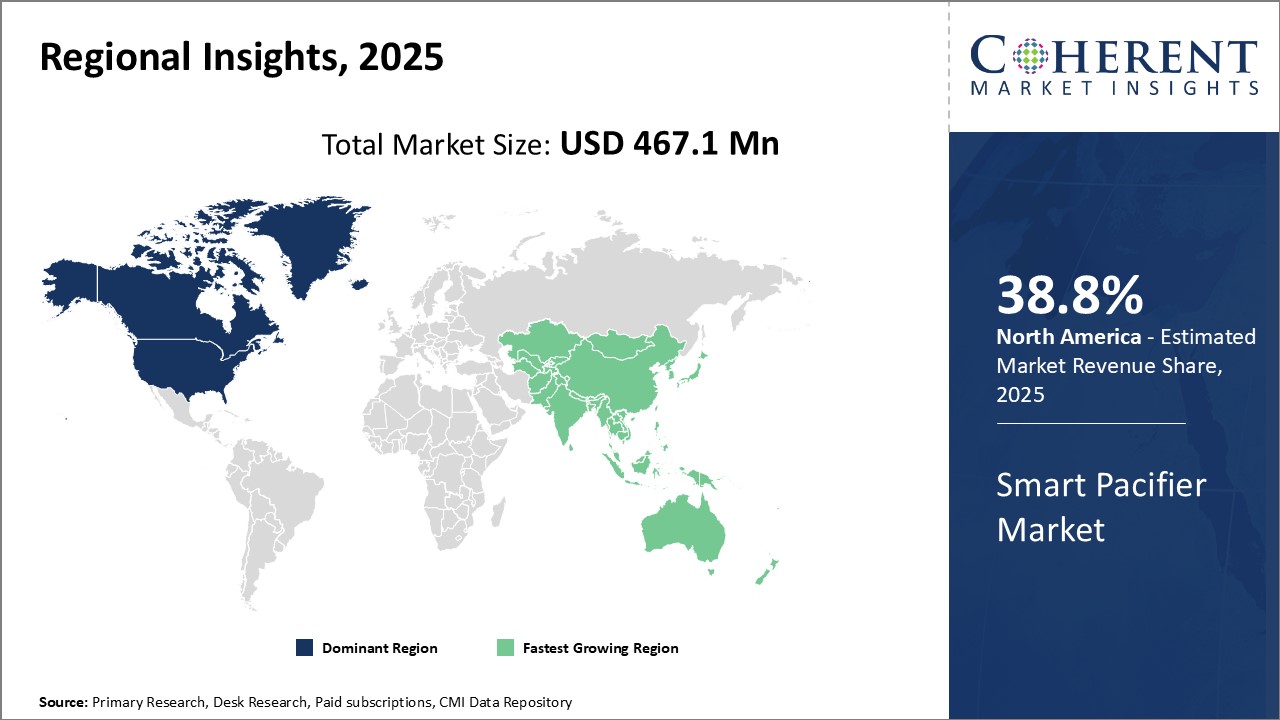
Need a Different Region or Segment? Download Free Sample
North America remains the dominant region in the global smart pacifier market and is estimated to hold 38.8% of the market share in 2025. With the presence of major manufacturers and technological advancements, the U.S. and Canada account for over 40.5% of the worldwide sales. Parents in the region are more receptive to innovative baby products and willing to pay a premium for features ensuring the health and safety of infants. Additionally, high disposable incomes allow consumers to spend on high-tech accessories. The export market is also substantial as North American companies supply their smart pacifiers globally.
Meanwhile, Asia Pacific has emerged as the fastest-growing market for smart pacifiers. Several factors are driving the growth in the region. There is a rising population and growing middle class with increasing spending power in countries such as China, India and other Southeast Asian nations. More families can afford smart variants compared to conventional options. Awareness about utility-based features is increasing among parents as they seek tools to monitor infants discreetly. Local manufacturing is ramping up as well. For example, Chinese brands are giving global competitors a tough challenge by providing quality products at affordable price points. Their export numbers to markets in the West and within the region have been rising sharply.
Market Report Scope
Smart Pacifier Market Report Coverage
| Report Coverage | Details | ||
|---|---|---|---|
| Base Year: | 2024 | Market Size in 2025: | USD 467.1 Mn |
| Historical Data for: | 2020 To 2024 | Forecast Period: | 2025 To 2032 |
| Forecast Period 2025 to 2032 CAGR: | 5.6% | 2032 Value Projection: | USD 684.5 Mn |
| Geographies covered: |
|
||
| Segments covered: |
|
||
| Companies covered: |
Brainchild Technologies, LLC, Root3 Labs, BlueMaestro, Washington State University, NiNite , Nouvo Health |
||
| Growth Drivers: |
|
||
| Restraints & Challenges: |
|
||
Uncover macros and micros vetted on 75+ parameters: Get instant access to report
Smart Pacifier Industry News
- In May 2022, researchers from Washington State University's School of Engineering and Computer Science stated that a wireless, bioelectronic pacifier could replace the need for invasive, twice-daily blood draws to monitor babies' electrolytes in Newborn Intensive Care Units, or NICUs. This smart pacifier can also enable more consistent monitoring of sodium and potassium ion levels. These electrolytes signal caregivers when babies get dehydrated, which is dangerous for infants, particularly those born prematurely or with severe health concerns.
- In February 2020, a group of researchers from Spain's University of Alcalá, in collaboration with engineers from the Department of Nanoengineering at the University of California, San Diego, set out to develop a sensor that babies use with a pacifier. The prototype is designed to test glucose levels. The sensor and all electronics are maintained on the outside of the pacifier, so neither the baby nor the sensor are at risk.
*Definition: The smart pacifier market consists of advanced pacifiers that are equipped with various technologies to track infant behavior and health. These smart pacifiers can monitor sucking patterns, breathing rate, heart rate and other vitals and send the real-time data to a connected mobile device. They aim to provide parents with insights into their baby's needs and detect any potential issues early. The growing demand for convenient and intelligent baby care products is fueling the growth of this emerging smart pacifier market.
Market Segmentation
- Application Insights (Revenue, USD MN, 2020 - 2032)
- Electrolyte Monitoring
- Glucose Monitoring
- Temperature Monitoring
- Others
- End User Insights (Revenue, USD MN, 2020 - 2032)
- Hospitals
- Specialty Clinics
- Homecare Settings
- Others
- Regional Insights (Revenue, USD MN, 2020 - 2032)
- North America
- U.S.
- Canada
- Latin America
- Brazil
- Argentina
- Mexico
- Rest of Latin America
- Europe
- Germany
- U.K.
- Spain
- France
- Italy
- Russia
- Rest of Europe
- Asia Pacific
- China
- India
- Japan
- Australia
- South Korea
- ASEAN
- Rest of Asia Pacific
- Middle East
- GCC Countries
- Israel
- Rest of Middle East
- Africa
- South Africa
- North Africa
- Central Africa
- North America
- Key Players Insights
- Brainchild Technologies, LLC
- Root3 Labs
- BlueMaestro
- Washington State University
- NiNite
- Nouvo Health
Share
Share
About Author
Manisha Vibhute is a consultant with over 5 years of experience in market research and consulting. With a strong understanding of market dynamics, Manisha assists clients in developing effective market access strategies. She helps medical device companies navigate pricing, reimbursement, and regulatory pathways to ensure successful product launches.
Missing comfort of reading report in your local language? Find your preferred language :
Transform your Strategy with Exclusive Trending Reports :
Frequently Asked Questions
EXISTING CLIENTELE
Joining thousands of companies around the world committed to making the Excellent Business Solutions.
View All Our Clients
